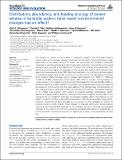Files in this item
Distribution, abundance, and feeding ecology of baleen whales in Icelandic waters: have recent environmental changes had an effect?
Item metadata
| dc.contributor.author | Vikingsson, Gisli A | |
| dc.contributor.author | Pike, Daniel G | |
| dc.contributor.author | Valdimarsson, Héðinn | |
| dc.contributor.author | Schleimer, Anna | |
| dc.contributor.author | Gunnlaugsson, Thorvaldur | |
| dc.contributor.author | Silva, Teresa | |
| dc.contributor.author | Elvarsson, Bjarki Þ | |
| dc.contributor.author | Mikkelsen, Bjarni | |
| dc.contributor.author | Øien, Nils | |
| dc.contributor.author | Desportes, Geneviève | |
| dc.contributor.author | Bogason, Valur | |
| dc.contributor.author | Hammond, Philip Steven | |
| dc.date.accessioned | 2015-06-01T11:10:09Z | |
| dc.date.available | 2015-06-01T11:10:09Z | |
| dc.date.issued | 2015-02-17 | |
| dc.identifier | 169907108 | |
| dc.identifier | a8230ca6-6dbc-46d4-b181-e9966f7f31cc | |
| dc.identifier | 85047964537 | |
| dc.identifier | 000485318800014 | |
| dc.identifier.citation | Vikingsson , G A , Pike , D G , Valdimarsson , H , Schleimer , A , Gunnlaugsson , T , Silva , T , Elvarsson , B Þ , Mikkelsen , B , Øien , N , Desportes , G , Bogason , V & Hammond , P S 2015 , ' Distribution, abundance, and feeding ecology of baleen whales in Icelandic waters: have recent environmental changes had an effect? ' , Frontiers in Ecology and Evolution , vol. 3 , 6 . https://doi.org/10.3389/fevo.2015.00006 | en |
| dc.identifier.issn | 2296-701X | |
| dc.identifier.other | ORCID: /0000-0002-2381-8302/work/47531618 | |
| dc.identifier.uri | https://hdl.handle.net/10023/6720 | |
| dc.description | Date of Acceptance: 13/01/2015 | en |
| dc.description.abstract | The location of Iceland at the junction of submarine ridges in the North-East Atlantic where warm and cold water masses meet south of the Arctic Circle contributes to high productivity of the waters around the island. During the last two decades, substantial increases in sea temperature and salinity have been reported. Concurrently, pronounced changes have occurred in the distribution of several fish species and euphausiids. The distribution and abundance of cetaceans in the Central and Eastern North Atlantic have been monitored regularly since 1987. Significant changes in the distribution and abundance of several cetacean species have occurred in this time period. The abundance of Central North Atlantic (CNA) humpback and fin whales has increased from 1800 to 11,600 and 15,200 to 20,600, respectively, in the period 1987–2007. In contrast, the abundance of minke whales on the Icelandic continental shelf decreased from around 44,000 in 2001 to 20,000 in 2007 and 10,000 in 2009. The increase in fin whale abundance was accompanied by expansion of distribution into the deep waters of the Irminger Sea. The distribution of the endangered blue whale has shifted northwards in this period. The habitat selection of fin whales was analyzed with respect to physical variables (temperature, depth, salinity) using a generalized additive model, and the results suggest that abundance was influenced by an interaction between the physical variables depth and distance to the 2000 m isobaths, but also by sea surface temperature (SST) and sea surface height (SSH), However, environmental data generally act as proxies of other variables, to which the whales respond directly. Overall, these changes in cetacean distribution and abundance may be a functional feeding response of the cetacean species to physical and biological changes in the marine environment, including decreased abundance of euphausiids, a northward shift in summer distribution of capelin and a crash in the abundance of sand eel. | |
| dc.format.extent | 18 | |
| dc.format.extent | 10065232 | |
| dc.language.iso | eng | |
| dc.relation.ispartof | Frontiers in Ecology and Evolution | en |
| dc.subject | Climate change | en |
| dc.subject | Finwhale | en |
| dc.subject | Common minke whale | en |
| dc.subject | Whale abundance | en |
| dc.subject | Feeding ecology | en |
| dc.subject | Humpback whale | en |
| dc.subject | Oceanic warming | en |
| dc.subject | Habitat modeling | en |
| dc.subject | QH301 Biology | en |
| dc.subject | NDAS | en |
| dc.subject | SDG 13 - Climate Action | en |
| dc.subject | SDG 14 - Life Below Water | en |
| dc.subject.lcc | QH301 | en |
| dc.title | Distribution, abundance, and feeding ecology of baleen whales in Icelandic waters: have recent environmental changes had an effect? | en |
| dc.type | Journal article | en |
| dc.contributor.institution | University of St Andrews. School of Biology | en |
| dc.contributor.institution | University of St Andrews. Sea Mammal Research Unit | en |
| dc.contributor.institution | University of St Andrews. Marine Alliance for Science & Technology Scotland | en |
| dc.contributor.institution | University of St Andrews. Scottish Oceans Institute | en |
| dc.contributor.institution | University of St Andrews. Centre for Research into Ecological & Environmental Modelling | en |
| dc.identifier.doi | 10.3389/fevo.2015.00006 | |
| dc.description.status | Peer reviewed | en |
This item appears in the following Collection(s)
Items in the St Andrews Research Repository are protected by copyright, with all rights reserved, unless otherwise indicated.

